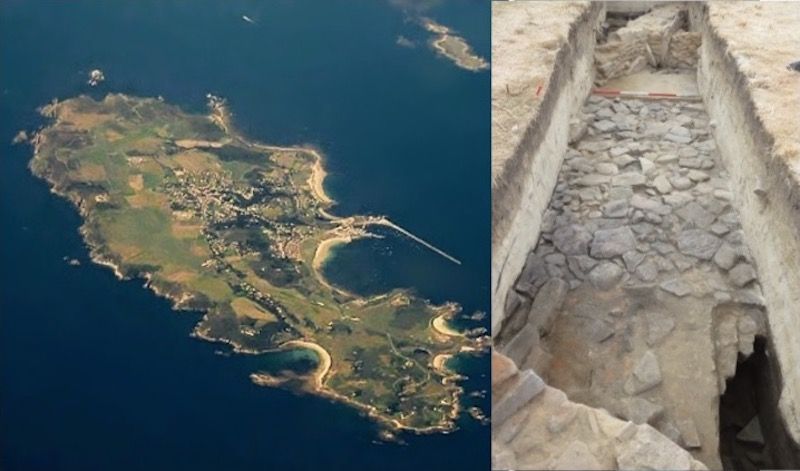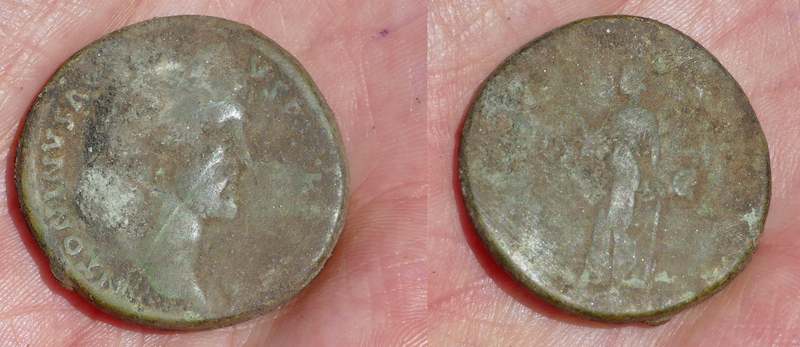

Archaeologists have been given the go ahead to bring up more buried secrets from what could be one of the most significant Roman settlements in Britain.
A dig in Alderney last summer revealed a Roman paved courtyard and chest high walls a metre or so under the scrub at Longis Bay. The site also yielded a second century bronze coin, a glass bead and good quality pottery fragments - indicators that people of some status may have lived and worked there almost 2,000 years ago.
Those doing the dig say one of the most intriguing aspects of the site is its scale. The network of masonry unearthed last July is believed to be part of a larger site covering some 40,000 square metres of land.
Archeologists said the finds offered the tantalizing possibility of Roman streets and villas waiting to be discovered under the blanket of windblown sand which eventually covered the site.
Pictured: A Roman pavement uncovered in Alderney. Pictured by Dr Phil de Jersey.
Earlier this month Guernsey's Head of Heritage Services Dr Jason Monaghan and States of Guernsey Archeologist Dr Phil de Jersey were granted permission from Alderney's General Services Committee to extend their search in a three week dig from August 11. They'ill be joined by local volunteers and students from a UK university.
Dr Monaghan said: “This is a unique and extensive site bigger than anything we have seen in the Channel Islands or adjacent French coasts.
“The sand preserves the bone, pottery and metal objects we need to date and interpret the site.”
Dr Monaghan said the team had a number of objectives to achieve this year. They aim to reopen the trench east of Rue des Mielles where the stone pavement was found in a bid to discover more about the building it belongs to.
“In the same area we hope to go deeper to confirm our suspicions that the Romans built on top of the earlier Iron Age cemetery, which appears much richer than would be expected on a small island.”

Pictured: Two bronze Roman coins found in Alderney. Pictured by Dr Phil de Jersey.
Graham McKinley, chairman of the GSC, said the States welcomed the team's return.
“They are slowly unravelling a fascinating history in that part of the Island which could prove a very valuable asset for Alderney,” he said.
Alderney is already home to the best preserved Roman fortlet in the Channel Islands and UK. The fourth century fortification at the Nunnery was believed to have been built to protect Longis harbour, which sheltered Roman vessels which patrolled the Channel. For the past decade the Nunnery has been the focus of archeological exploration.
But in 2017 workmen digging a service trench along the Rue des Mielles unearthed a skull and bones. They were found to be second and first century BC Iron Age remains from a burial site adjacent to and under the road.
The objective of last year's dig was to learn more about the extent of the Iron Age burial ground and archeologists duly discovered the remains of 12 burials. But to their surprise they also found evidence of a Roman settlement pre-dating the Nunnery.
They now hope the site in Alderney will become the regular destination for a UK university's summer field school, an idea to be trialled this year.
To find out more about the dig follow the action on Facebook via Dig Alderney.
Pictured above and top: Images from the Roman dig courtesy of Dr Phil de Jersey.
Comments
Comments on this story express the views of the commentator only, not Bailiwick Publishing. We are unable to guarantee the accuracy of any of those comments.